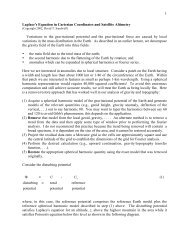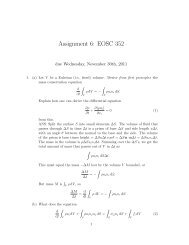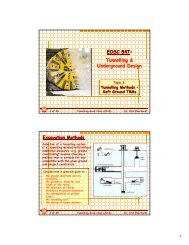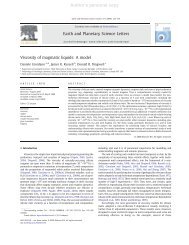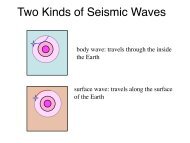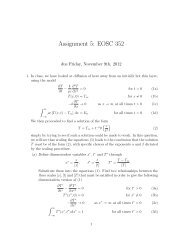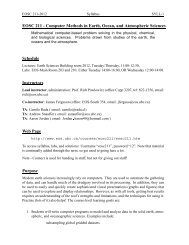Elastic Rebound Theory The Earthquake Cycle Coseismic surface ...
Elastic Rebound Theory The Earthquake Cycle Coseismic surface ...
Elastic Rebound Theory The Earthquake Cycle Coseismic surface ...
- No tags were found...
Create successful ePaper yourself
Turn your PDF publications into a flip-book with our unique Google optimized e-Paper software.
Displacement vectors for a shorter ruptureNote the vectors off the ends of the rupture are NOT parallel to the fault.<strong>The</strong>y are perpendicular to the fault along strike beyond the ends of the rupture.Both the east component and the north component of displacement canvary with position.Displacement magnitude decreases with distance.2D horizontal displacement pattern at theEarth!s <strong>surface</strong>, from a model of a shortstrike-slip fault (red line)Plan viewHere is what interseismic (between-earthquake) velocitiesof points on the ground around a fault look likeMER1SILEKANTKRDM AKCO KANRSELPAVCI TUBIPIREKAZI KDERBOZTOLUK SEFIFIS1 CINADUMTKTOPMEKEAGUZIGAZIUCKKUTESEYHTEBADALAP DEVRYIGIABATKIBRHMZANALLULUTCMLNMHGZLTFYD!ESKISIVR28 mm/yrANKRBlue = pre!Izmit earthquake GPS site velocities, 1!sigmaerrors. Pink = modeled velocities.
Interseismic (between-earthquake) velocities of points onthe ground: magnitude versus distanceD D!this can be modeled using a simple arctangent functionthe relative plate motion rate is 25 mm per yearbut there is no sudden jump in velocity across the plateboundaryfaultOne idea about how faults work at depthplate 1plate 2lithosphereasthenospherefaults and earthquakes inthe upper crustplates are STUCKtogether in the top 20km, except when anearthquake allowssudden relative motionslowly flowing (creeping)narrow zone at depth:extends plate boundarydown to the asthenosphereSTEADY* “interseismic”relative motion of plates atthis depth*not exactly... but ok for now
SAF model based on survey data in the Lawson Report(1906 displacements)slow steady motionin this sense(noted 1857-1906)relative motion of rigid platesIf the lithosphere is elastic, then stressesbuild up as it warps.<strong>Elastic</strong>ity: more distortion (strain) --> more stressRecall Hooke!s Law from 1st year (or high school)physics: stretch a spring --> elastic force resists pulling
<strong>Elastic</strong> <strong>Rebound</strong> <strong><strong>The</strong>ory</strong> of Reid (1908), based on surveydata from the 1906 Lawson Report<strong>Elastic</strong> stresses build up asrock deforms slowly over timeRupture occurs when elasticstresses exceed what the fault canbear (friction).Rocks along fault spring back toundeformed state (“elastic rebound”)Cascadia Subduction Zoneyou are here
Cascadia subduction zone earthquake cycleinterseismic (300-600 yr)coseismic (minutes)How to make an earthquake:Build up enough shear stress to exceed thefrictional strength of a fault, over a large enoughspatial <strong>surface</strong> area of a frictionally unstable(“velocity weakening”) fault(1) Building up shear stress:We must define strain, elasticity, and stress (shearstress and normal stress). First: strain and how wemeasure it with GPS.
How to make an earthquake:Build up enough shear stress to exceed thefrictional strength of a fault, over a large enoughspatial <strong>surface</strong> area of a frictionally unstable(“velocity weakening”) fault(1) Building up shear stress:We must define strain, elasticity, and stress (shear stress and normal stress).First: strain and how we measure it with GPS.(2) Frictional strength of the fault:We must define friction and (with normal stress) thestrength of the faultHow to make an earthquake:Build up enough shear stress to exceed thefrictional strength of a fault, over a large enoughspatial <strong>surface</strong> area of a frictionally unstable(“velocity weakening”) fault(1) Building up shear stress:We must define strain, elasticity, and stress (shear stress and normal stress).First: strain and how we measure it with GPS.(2) Frictional strength of the fault:We must define friction and (with normal stress) the strength of the fault(3) Other required conditions (“velocityweakeningfriction”, “large enough area” of thefault:We must understand the stability criteria for failure onthe fault, that is, conditions leading to an earthquakerather than steady frictional creep on the fault




